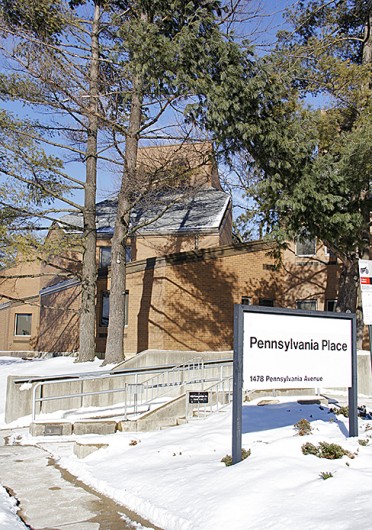
Pennsylvania Place is located on South Campus at 1478 Pennsylvania Ave. It is set to house the Recovery House at Penn Place beginning Fall Semester 2014.
Credit: Ritika Shah / Asst. photo editor
“My freshman and sophomore years of high school, I partied a lot. It was all I cared about.”
“It was whatever, and then I got really suicidal and tried to kill myself because my drinking was out of control.”
“I kept on going to the hospital because I kept on overdosing and mixing drugs with alcohol.”
“I couldn’t handle myself and I started going to (Alcoholics Anonymous) when I was 16.”
These are parts of the story of Haley Schuster, a third-year in special education and a member of the Collegiate Recovery Community at Ohio State — an organization that is set to secure an on-campus living option starting Fall Semester 2014 for students in recovery from drug or alcohol addictions.
The residence hall, which is currently called Pennsylvania Place and located on South Campus at 1478 Pennsylvania Ave., is set to hold 28 beds. Students living in the Recovery House at Penn Place would live in two-person dorm rooms with private baths. The CRC students are slated to live clustered in a wing or on a floor, and the remaining rooms at Pennsylvania Place are to be filled with students who choose to live there based on its standing as a sober environment, said Sarah Nerad, graduate administrative associate for the CRC and Recovery House.
“No additional funds (from the administration) are being put into the Recovery House,” Student Life spokesman Dave Isaacs said. “It will cost the same as any other on-campus residence hall (for students).”
Students interested in joining the CRC and living in the Recovery House at Penn Place next year are required to fill out an application.
“The application asks some basic demographic questions, a treatment history, drug and alcohol use history, eating disorder history (and so on),” Nerad said. “This will allow us to make sure that we appropriately refer student to services. If a student is like, ‘Hey, actually I’ve also been in treatment for an eating disorder,’ I’m able to be like, ‘OK, then that is something that we need to make sure we support you in.’”
Nerad added that applicants are required to submit two letters of recommendation from a treatment provider or sponsor, but their application isn’t just for housing.
“The application for the CRC and Recovery House is also a scholarship application, and it allows students to have priority registration,” Nerad said.
One scholarship of $2,000 will be awarded to a CRC student. The funds for this scholarship came from an anonymous donor, Nerad said.
Nerad said she hopes eight CRC students will live in the recovery house, because “eight is a good number.”
“If we had 28 students in recovery living in there, it might be a lot to handle,” she said.
The CRC currently has 35 members, but the average age is of its members is 25, Nerad said, so she’s hoping new students will join the CRC and choose this on-campus living option.
“All first-years have to live on campus, and now we’re phasing in all second-years. That’s a lot of people. There are people who get sober in high school, and they’re going to pick us. They’re going to come here so they can live in a dorm that supports them,” Nerad said.
OSU is set to begin requiring second-year students to live on campus beginning Fall Semester 2016.
CRC students living in the recovery house will likely not have any additional mandatory commitments, aside from a potential monthly house meeting, Nerad said, because the goal is to provide the students with a normal college experience.
The students in the recovery house will have a resident adviser, who “might be a person in recovery. We’re not sure yet,” Nerad said.
Schuster said she might be interested in becoming that RA because of her past experience working in residence life at the University of Akron, where she attended her first two years of college before transferring to OSU this past fall.
No matter what happens for her, Schuster said this living option is an important one for students to have and one that might have saved her some trouble her freshman year of college.
After entering AA at 16, Schuster still struggled with alcohol.
“I would drink occasionally, and then I got sober my senior year (of high school) after getting a DUI,” she said.
Going into college, Schuster was optimistic.
“I did everything I could (to stay sober) that summer (after graduation),” she said. “I drank my freshman year of college, but it only lasted a month, and I didn’t get into any trouble.
“When I did drink, I was living in a living-learning community where all of us are freshman, and we have had our parents up our butts our whole lives and we’re like, ‘We can do whatever we want, so let’s drink all night’ … That’s why I think it’s important that they have places like this for people like me who had every intention of staying sober in college.”
Nerad agreed it’s important to have a pre-existing support community for students in recovery.
“If you are starting school, and you also have to hit up a bunch of different recovery support meetings and try to find a network, that stuff takes time, and it’s really hard to do when you’re in school and working,” Nerad said.
Schuster said even though she only attended a few CRC meetings and events last semester, she has appreciated having the resources present.
“If I ever get an ‘oh crap’ moment or I’m really struggling, I know that Sarah is going to be in her office during her office hours or that there is going to be the meeting on Wednesday or things like that,” she said. “It’s in the back of my mind, whether I’m thinking about it or not.”


